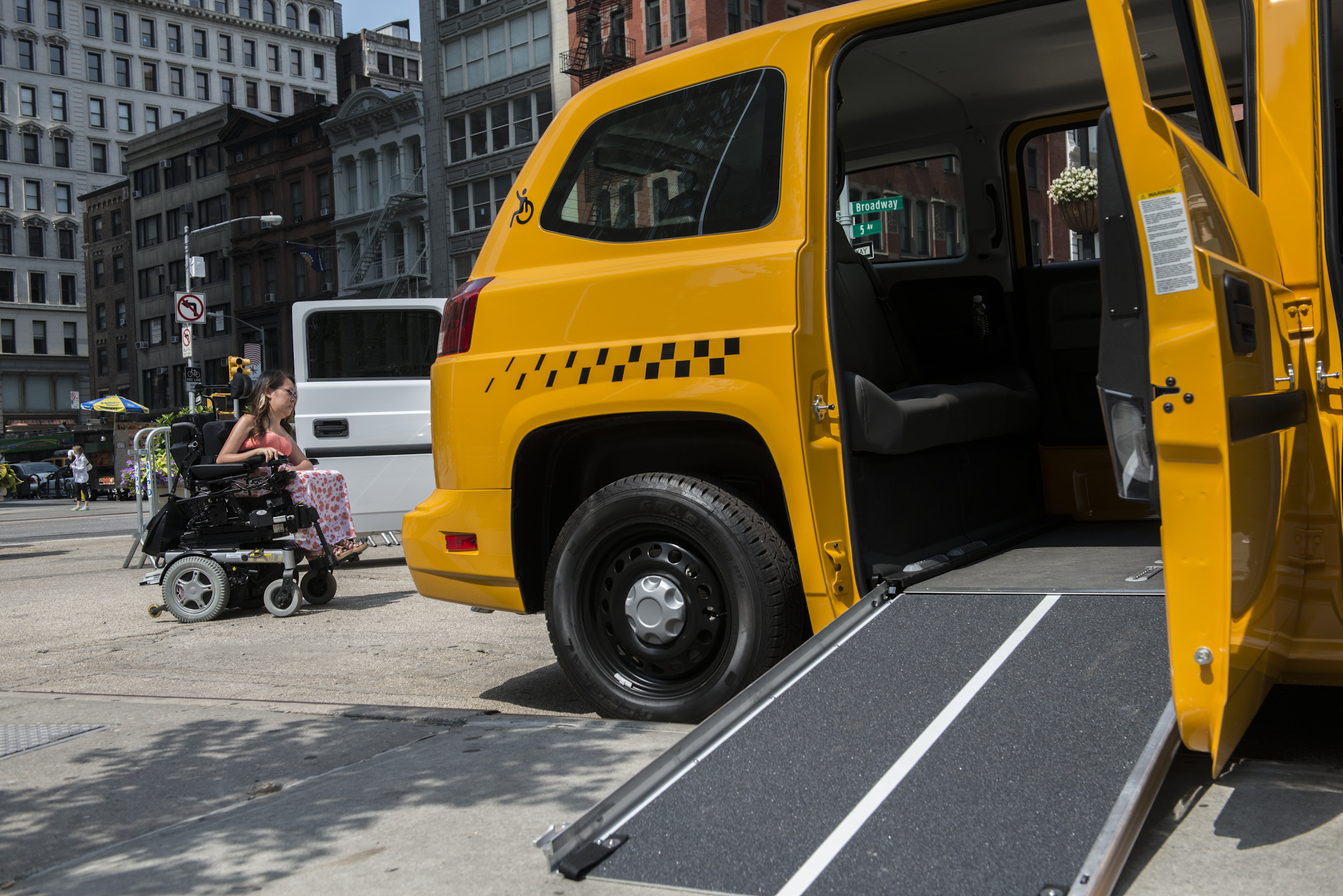NYC denies disabled people more accessible transportation
NYC denies disabled people more accessible transportation Prism


Disability Rights Advocates File Motion Against New York City Taxi and Limousine Commission

Disability Rights Advocates (DRA) and the law firm Sheppard Mullin have filed a motion against the New York City Taxi and Limousine Commission (TLC) over their failure to follow through on an agreement to make at least 50% of cabs wheelchair accessible by 2020. The motion was filed on behalf of a coalition of people with disabilities, including the Taxis for All Campaign and Disabled In Action.
Background
The TLC made the agreement in a 2014 settlement to a federal class-action lawsuit, which was filed in 2011 under Title II of the Americans with Disabilities Act. When the case began, only 231 of the city’s cabs were wheelchair accessible. After failing to meet the initial deadline, citing struggles at the start of the COVID-19 pandemic, the TLC was given extensions—which they once again failed to meet by 2023.
Sustainable Development Goals (SDGs)
- Goal 10: Reduced Inequalities
- Goal 11: Sustainable Cities and Communities
Current Situation
According to Chloe Holzman, a senior staff attorney at DRA, the TLC’s latest report stated that the total percentage of authorized medallion vehicles that were wheelchair accessible was 32%, well under the 50% clearly stated in the settlement. With New York being one of the best cities for transportation in the country, the low bar concerns advocates. There are nearly 1 million people with disabilities in the five boroughs, according to the New York City Mayor’s Office for People with Disabilities. That’s about 11% of the population. And census data suggests that about 1 in 15 New Yorkers has an ambulatory disability, meaning they are sometimes or fully impeded from walking.
“People with disabilities are not prioritized. We’re not even equalized, which is really frustrating,” said Jean Ryan, the president of Disabled in Action, which has been organizing since the 1970s. According to the TLC’s most recent report to DRA, there were 4,297 wheelchair-accessible vehicles in the entire licensed fleet as of June 2023. But that doesn’t translate to lived experience, Ryan tells Prism. It’s still random luck if someone hails a cab and it’s accessible for wheelchairs, and even then not all drivers want to make the effort.
Ryan points out that 32% of the taxi fleet being technically accessible doesn’t mean those vehicles are in service at all times, making the number much lower in reality. And with the city recently limiting programs that provide greater autonomy—like a subsidized taxi service for disabled riders—things are feeling dire. Accessible taxis are crucial on their own, but the matter is especially pressing given that other options for transportation are not accessible either.
Transportation Challenges for Disabled People
Currently, only approximately 30% of the subway system in New York City is accessible under the Americans with Disabilities Act (ADA), meaning they are able to accommodate riders with disabilities and can be navigated without climbing stairs. Even then, many accessible subway stations’ elevators frequently break down, causing disabled people to face circumstances like being carried up many steps. Buses can be slow, crowded, and unreliable. Paratransit like Access-A-Ride requires scheduling in advance and often doesn’t show up, which prevents spontaneous travel. Holzman points out that rideshare apps require smartphones that not all New Yorkers—and visitors, disabled or not—have.
Impact on Quality of Life
Plaintiffs met with representatives from the Adams administration in January to discuss its intentions to be relieved from the requirements of the settlement agreement. The DRA motion cites that inaccessible taxis have resulted in high unemployment rates and references that some members of the suit have even had to wheel themselves to the hospital because of “the dearth of accessible taxis.”
This disregard has sorely impacted disabled people’s quality of life in the five boroughs. Wheelchair users must plan more meticulously about when it’s worth it to leave the house and if they’ll be stranded somewhere. Anything that’s more spontaneous—being sick and needing to go to the doctor or trying to make last-minute plans with a friend—becomes impossible. And Ryan argues that it’s just as important for disabled people to be able to make fun plans that they can get reliable transportation to as it is to run errands or go to the doctor.
Importance of Accessible Taxis
Ryan emphasizes how important it is to be able to go out on the street and hail a cab, knowing you’ll be able to get to your destination—a certainty not afforded to her and others who use wheelchairs. “These are the only vehicles that you can legally hail in New York City … Cabs have been around for over 100 years,” Ryan said. Tourists without local phone plans, people without smartphones for Ubers and Lyfts, wheelchair users, and anyone in a bind should be able to simply get a taxi—which is often more affordable and doesn’t implement surge pricing.
TLC’s Obligation
The TLC’s failure to comply with its accessibility obligations is “absolutely compounded by the lack of accessible travel alternatives for wheelchair users,” Holzman said, adding that even with any viable alternatives, the TLC still has an obligation to serve wheelchair users just like it serves other customers. “Wheelchair users need to have access to taxi service like anyone else.”
Conclusion
The direction this case goes in will have a major impact. For now, advocates are waiting to see how Judge George Daniels will rule and hoping it will be in the favor of disabled New Yorkers.
SDGs, Targets, and Indicators
1. SDGs Addressed:
- SDG 10: Reduced Inequalities
- SDG 11: Sustainable Cities and Communities
2. Specific Targets:
- SDG 10.2: By 2030, empower and promote the social, economic, and political inclusion of all, irrespective of age, sex, disability, race, ethnicity, origin, religion, or economic or other status.
- SDG 11.2: By 2030, provide access to safe, affordable, accessible, and sustainable transport systems for all, improving road safety, notably by expanding public transport, with special attention to the needs of those in vulnerable situations, women, children, persons with disabilities, and older persons.
3. Indicators:
- Indicator for SDG 10.2: Proportion of the population with disabilities who have access to transportation services.
- Indicator for SDG 11.2: Proportion of taxis and public transport vehicles that are wheelchair accessible.
Table: SDGs, Targets, and Indicators
| SDGs | Targets | Indicators |
|---|---|---|
| SDG 10: Reduced Inequalities | Target 10.2: By 2030, empower and promote the social, economic, and political inclusion of all, irrespective of age, sex, disability, race, ethnicity, origin, religion, or economic or other status. | Indicator: Proportion of the population with disabilities who have access to transportation services. |
| SDG 11: Sustainable Cities and Communities | Target 11.2: By 2030, provide access to safe, affordable, accessible, and sustainable transport systems for all, improving road safety, notably by expanding public transport, with special attention to the needs of those in vulnerable situations, women, children, persons with disabilities, and older persons. | Indicator: Proportion of taxis and public transport vehicles that are wheelchair accessible. |
Analysis:
1. SDGs Addressed:
The issues highlighted in the article are connected to SDG 10: Reduced Inequalities and SDG 11: Sustainable Cities and Communities. The article discusses the lack of accessibility and inclusion for people with disabilities in transportation services, which relates to the goal of reducing inequalities and creating sustainable cities.
2. Specific Targets:
Based on the article’s content, the specific targets that can be identified are:
– Target 10.2: By 2030, empower and promote the social, economic, and political inclusion of all, irrespective of age, sex, disability, race, ethnicity, origin, religion, or economic or other status.
– Target 11.2: By 2030, provide access to safe, affordable, accessible, and sustainable transport systems for all, improving road safety, notably by expanding public transport, with special attention to the needs of those in vulnerable situations, women, children, persons with disabilities, and older persons.
3. Indicators:
The article mentions or implies the following indicators that can be used to measure progress towards the identified targets:
– Indicator for SDG 10.2: Proportion of the population with disabilities who have access to transportation services. The article highlights the lack of accessible taxis and public transport options for people with disabilities, indicating a lack of inclusion and accessibility.
– Indicator for SDG 11.2: Proportion of taxis and public transport vehicles that are wheelchair accessible. The article discusses the failure of the New York City Taxi and Limousine Commission to meet the agreement of making at least 50% of cabs wheelchair accessible by 2020, indicating a lack of progress in providing accessible transport options.
By analyzing the article, it is evident that the issues discussed are relevant to SDG 10: Reduced Inequalities and SDG 11: Sustainable Cities and Communities. The specific targets identified are Target 10.2 and Target 11.2, which focus on promoting inclusion and providing accessible transport systems. The indicators mentioned in the article, such as the proportion of the population with disabilities who have access to transportation services and the proportion of wheelchair-accessible taxis and public transport vehicles, can be used to measure progress towards these targets.
Behold! This splendid article springs forth from the wellspring of knowledge, shaped by a wondrous proprietary AI technology that delved into a vast ocean of data, illuminating the path towards the Sustainable Development Goals. Remember that all rights are reserved by SDG Investors LLC, empowering us to champion progress together.
Source: prismreports.org

Join us, as fellow seekers of change, on a transformative journey at https://sdgtalks.ai/welcome, where you can become a member and actively contribute to shaping a brighter future.







